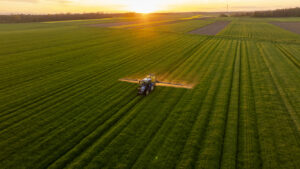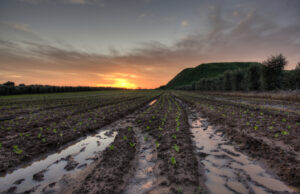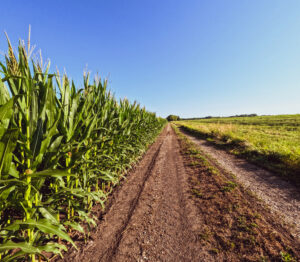Written by Gilly Kinsky, VP Marketing, CropX
Every farmer knows the feeling: you walk a field after a rain and the question hits: Did I just lose my nitrogen?
You can’t see it, smell it, or measure it on the spot. You just have to guess. And in agriculture, guessing is expensive.
Real-world data shows just how much can disappear, and how quickly.
In a CropX field trial in New Zealand, one lysimeter recorded a loss of 66 kg/ha (58 lb/acre) of nitrogen to leaching following fertilizer application and a rain event, an example of how fast nutrients can move beyond the root zone. By the time a tissue test or yield map shows the impact, that investment is already gone.
A separate 234-day field experiment in Michigan drives the same point home. Researchers held total rainfall constant but changed how it fell, fewer, larger storms versus frequent, smaller ones. The results showed that larger, less frequent storms triggered far higher nitrate leaching in tilled systems, no matter which fertilizer source was used. We learn that timing and water movement, not fertilizer chemistry, were the decisive factors. Interestingly, no-till soils were less affected, showing how soil structure can buffer against those timing shocks.
Together, these studies prove that nitrogen leaching isn’t just about what you apply, it’s about when the water arrives and how the soil handles it.
We Talk About Leaching Backwards
Most conversations about leaching start after the fact, when nitrogen has already moved below the root zone and the numbers show up in groundwater reports or efficiency charts. But by the time we’re measuring the loss, the real story is already over.
Leaching begins before the rain, in that uneasy window when soil moisture is high, fertilizer is freshly applied, and the forecast turns unpredictable. That’s when agronomy becomes risk management. A grower stands between two costly choices: apply now and risk flushing nutrients out of reach if a storm hits, or wait and risk holding the crop back during a critical growth stage.
It’s a lose-lose decision that plays out across millions of acres every season. And often, it’s a lack of visibility. Without knowing exactly how close a field is to saturation, or how fast water will move through the profile, timing becomes guesswork. And that uncertainty costs more yield than any single leaching event ever will.
Leaching Is a Timing Problem, Not a Chemistry Problem
We tend to blame the fertilizer form, urea vs. nitrate, stabilizers vs. none, but the chemistry is predictable. What isn’t predictable is the timing of water movement.
It’s not that nitrate suddenly becomes unstable; it’s that water shows up when it’s not supposed to. A three-inch storm after an application can undo perfect nutrient planning. That’s not bad agronomy, it’s bad timing.
Dealers Feel it Too
For dealers, this uncertainty shows up as churn. When yields slip after a wet spell, the first question is almost always about the product. Did it stabilize like it should have? Was the formulation right? Yet, more often than not, the fertilizer performed exactly as designed. The real variable is the one no one could see: water moving through the soil faster than expected.
Two fields, one rain event, and completely different results, that’s where certainty disappears. One grower sees solid performance, another sees loss, and both used the same blend on the same schedule. Without visibility into how water and nutrients interact below the surface, even good agronomy can look inconsistent.
The gap is missing information. And until we close it, both growers and dealers will keep having to defend decisions that data could easily explain.
Closing the Data Gap
We measure yield, moisture, EC, and soil type, but not nutrient movement in real time.
That’s like trying to run irrigation without ever checking the weather.
Leaching isn’t random; it’s patterned. It tends to happen in the same soils, after the same irrigation cycles, during the same weeks of the year. But we only notice it after the fact, when the tissue tests drop or the color fades in the canopy.
We only notice leaching after the fact, when the tissue tests drop or the color fades in the canopy. By then, it’s too late to fix, and too easy to misdiagnose.
The Opportunity
We don’t need to stop leaching entirely, we need to know when it’s happening. The key is continuous monitoring, knowing exactly what your crop is absorbing, how much nitrogen remains available for future growth, and if nutrients are slipping away when you’re not looking. Instead of wondering “Did I just lose my nitrogen?”, advanced sensor systems enable farmers to monitor plant uptake and utilization throughout the season, turning every leaching event into actionable information, not invisible loss.
With a season-long view of leaching events, growers and advisers can now track and report responsible nitrogen management practices, demonstrating stewardship to stakeholders and regulators. By understanding the conditions in terms of weather, soil moisture, and nutrient status, that precede or trigger leaching, users can adjust timing, application rates, and even fertilizer formulations to reduce risk in real time, not just after the fact.
A Quiet Revolution
Leaching is becoming less of a guessing game and more of a manageable metric. Solutions like the CropX nutrition monitoring solution provide growers with real-time insights into nitrogen movement, soil moisture, and leaching events across the season. By delivering simple records and actionable data through an easy-to-use dashboard, these tools help producers not just respond after the damage is done but actually anticipate and adapt their management before the next rain hits. For dealers and their customers, this shift means recommendations can be measured and refined, with evidence to back every decision. What was once invisible loss is now a data point that drives better agronomy and more resilient business practices.
See how real-time soil data can guide your next nutrient move. Contact CropX here.




